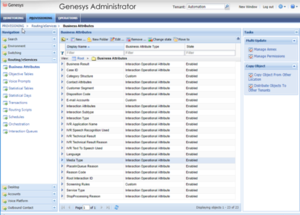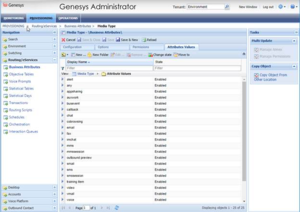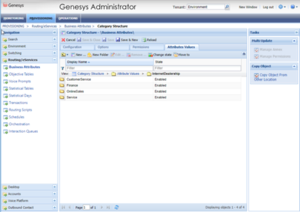Contents
- 1 Other Universal Routing 8.1.x Updates
- 1.1 URS Character Limitation
- 1.2 Distribution of Multimedia Interactions During Shutdown or Backup Mode
- 1.3 Removal of 9999 License Limit
- 1.4 Additional Information on HTTP Report Method
- 1.5 Maximum Length Limitation for Text Field on Web Service Object
- 1.6 Corresponding Genesys Administrator (GA) Screenshots for Old Configuration Manager (CME) Screenshots
- 1.7 Changes to the Limitations of Skill Expressions
Other Universal Routing 8.1.x Updates
This page contains other updates related to URS and IRD that are important to note.
URS Character Limitation
URS allows a maximum 1,023 characters for the combined length of a target name and a Stat Server name where the target name is the name of a corresponding Configuration Database object plus a Skill expression (if a Skill expression is used). Also see the Known Issues and Recommendations section of the Universal Routing Server 8.1.x release note.
Distribution of Multimedia Interactions During Shutdown or Backup Mode
Starting with 8.1.400.23, when URS shuts down or switches to backup mode, it distributes virtual queue events for multimedia interactions regardless of whether a backup URS exists. For voice calls, the URS behavior is the same as previous – virtual queue events are distributed only if there is no backup URS.
Removal of 9999 License Limit
Starting with 8.1.400.33, the maximum number of licenses to check out from License Server is extended from 9999 to 1,000,000 seats. Upon startup, URS checks out all available number of router_seats defined in License Server. When fewer licenses than available are needed, start URS with a new startup command line parameter: -licnum <number of licenses>.
Additional Information on HTTP Report Method
In addition to the information provided on the HTTP Report method on page 816 of the Universal Routing 8.1. Reference Manual (Supported Methods section in Appendix C), the Report method also supports the following input parameters:
- ar - information about agent reservation effectiveness.
- seats - provides information about URS licenses (router_seats) usage.
- tserver - name of T-Server for which information is required.
In the sample tserver method provided on the same page, note that timing related data in the response provides information about the average time (in milliseconds) that a particular category of calls spent being in one or another strategy execution state. When any function is executed and is waiting for an external event to trigger its continuation, the call is placed in a corresponding waiting state. During this stage, the following states are provided in reporting:
- t - time spent on mandatory treatments
- x - time spent waiting for data from external servers
- s - time spent waiting for data from statserver
- w - time spent waiting for ready targets, returned by the Wait function, which is used by target selection objects
- r - time spent waiting for the route used event
- f - time spent on all other waiting functions
- n - the time the category of calls were not in any waiting state, that is, time spent in active calls or spent doing nothing and not running any strategy.
New cpu Parameter
A new parameter, cpu, is introduced in URS release 8.1.400.63, to provide URS CPU consumption, which can be used for monitoring the health status of URS applications.
There are 2 categories of URS activities - main and background. Main activity is related to executing strategies, responding to requests, etc. Background activity is mostly related to updating content of skill groups. URS collects and stores its CPU usage information for the latest 60 seconds of its work.
Output Parameters:
- base - is average CPU consumption on main URS activity. This is the primary parameter to be used to indicate URS loading.
- max - is detected peak of total CPU consumption including both main and background activities.
- base_max - is detected peak of main CPU consumption.
An example is given below.
Command:
urs/stat/report?cpu
Output:
<cpu>
<base>60</base>
<max>70</max>
<base_max>70</base_max>
</cpu>
Maximum Length Limitation for Text Field on Web Service Object
The maximum length of the input string in the Text field on the General tab of the Web Service object is limited to 1,010 bytes. (Appendix B, page 776 of the Universal Routing 8.1 Reference Manual)
Corresponding Genesys Administrator (GA) Screenshots for Old Configuration Manager (CME) Screenshots
There are references to CME on various pages of the Universal Routing 8.1 Reference Manual. As GA is now more widely used than CME, the equivalent or corresponding GA screenshots for the old CME screenshots from the manual are provided below as a point of reference:
Page Number 102: Media Type Business Attributes and Attribute Values
Page Numbers 178, 179, 183, and 201: Category Folders in Knowledge Manager
Page Number 419: Setting Permissions for a Person
Page Number 539: Updating Multiple Objects
Changes to the Limitations of Skill Expressions
The following limitations specified for skill expressions under the IRD Limitations section on pages 31 and 32 of the Universal Routing 8.1 Reference Manual, are no longer applicable:
- Routing objects cannot exceed 100 elements (skill names, numbers, comparisons, and logical operands).
- A skill expression should have no more than 25 constructions, such as English > 1.
However, there is a limit on the maximum number of characters allowed in a skill expression. A skill expression can have a maximum of 2933 characters.





